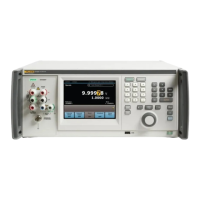5730A Sales and Demo Guide
Fluke Corporation Company Confidential Page 11 of 28
the screen to make it go fully blank. These settings were chosen to extend the life of the screen
while also accounting for safety in always showing the status of the calibrator.
10.5. Connection to 5725A & 52120A Amplifiers
The 5730A is compatible with both the Fluke Calibration 5725A Current Amplifier and the Fluke
Calibration 52120A Transconductance Amplifier. The amplifiers offer end users the capability of
increasing the calibrator’s current output to 11 A or 120 A for the 5725A and 52120A, respectively.
When connected to the 52120A or 5725A, the output screen on the 5730A displays the current level
output from the amplifier (i.e. you can program in 120 A into 5730A and the output will go to 120 A).
The 52120A-specific cable connecting the amplifier to the calibrator allows for two way, or “closed
loop,” communication between the devices. This provides for the ability of the 5730A to “drive” the
attached amplifier, while utilizing the best case specifications for each configuration. All necessary
data and output information is displayed on the 5730A color touchscreen panel. Up to three 52120A
amplifiers may be connected to one 5730A, offering the capability to output currents as high as 360
A AC. Refer to the Extended Specifications for 52120A accuracies; 5725A accuracies are included in
the 5700A/5720A manuals or available online.
10.6. Artifact Calibration
Artifact Calibration is an existing feature of the 5700A and 5720A Multifunction calibrators which has
been proven over the last 20 years. It is a means of completing a fully traceable calibrator
adjustment with only three external standards: 10 V, 1 Ω, and 10 kΩ. Artifact Calibration transfers
the assigned values of an external artifact to a large array of multidimensional parameters within the
instrument. The instrument takes over the manual metrology functions of establishing ratios and
making comparisons, as well as controlling the measuring process. Once completed, 24 hour or 90
day uncertainty specifications can be utilized when determining test uncertainty ratios compared to
the Unit Under Test (UUT). Artifact Calibration is not offered by competing multifunction calibrators
and has been fully verified by NIST and other regulating bodies. Artifact Calibration allows end users
to perform fully accredited calibrations themselves, thus extending the period of time between
sending the unit to a Fluke Service Center for a full verification to two years. This reduces the need
for additional shipping costs and downtime when the calibrator is returned to Fluke Service for
calibration. Customers can save significant costs in the form of shipping costs, shipping time, service
time, and calibration costs by performing Artifact Calibrations themselves. Also, if a customer does
not own the required external standards (Fluke 732B, A40B-1, and A40B-10K), US customers can
order a set of standards to be shipped directly to them. Currently, this service is not available
outside the US since the 732B must be energized at all times, and Fluke cannot guarantee the
battery will last during international shipments.

